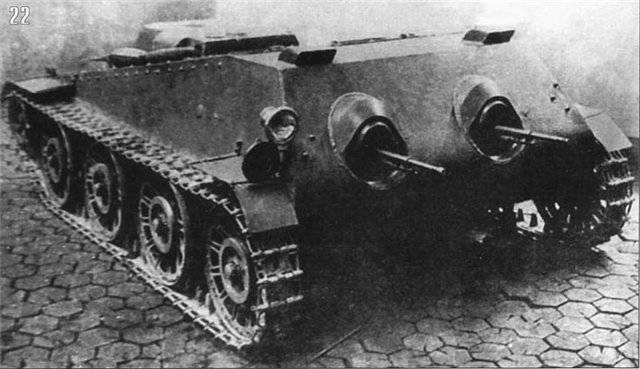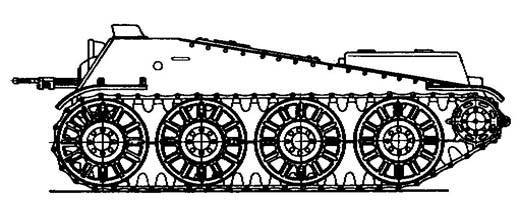Mobile Machine Gun Jack (BCP), or "217 Object"

PPG-1, "217 object"
The wedge was a rectangular armored hull mounted on a tracked chassis. The front was a combined combat compartment and a department of control, rear - the engine-transmission. Body tanketki welded. Armor on the sides had a thickness of 10 mm, and the frontal part - 20 mm. Bronelists were installed at small angles of inclination.
Chassis single side: four skating rink and drive sprocket at the rear. There was no steering wheel, the functions of which were performed by the front roller. The wedge was controlled using levers. The engine was installed in the rear part of the hull BCP. The power unit tanketki - carburetor engine PMZ (power 16 hp). The engine allowed to reach speed on the highway to 18 kilometers per hour. Due to the low engine power, the 217 Object struggled to rise more than 30 degrees, was unsatisfactory, and off-road capability. On the roof of the hull for the crew access there was a double hatch. The crew tanketki - two people.
As a weapon, two DT machine guns, installed in the frontal part of the tankette in ball bearings, served. General ammunition - 1575 cartridges (25 disc magazine for 63 cartridge). Such weak weapons were due to the fact that the mobile machine-gun nest was supposed to be used exclusively against infantry. A characteristic feature of the mobile machine-gun nest was the placement of the crew. The rear armored cover in the stowed position was folded back, and the crew of the wedge he was driving the machine while sitting. The rear armored cover in a combat position was closed, and the crew fired from a pair of machine guns in a recumbent position. This decision made it possible to radically reduce the height of the wedge and to provide it with an inconspicuous silhouette. For long distances, the BCP was to be transported by truck.

In 1940, one copy was made. The mobile machine-gun nest resembled the Sabathe wedge 1926 of the year. The main difference was the large thickness of armor and crawler chassis of a different design. BCP was submitted for factory tests. Immediately there was a question about the functionality of the wedge. The machine guns mounted on the wedge had limited firing angles, and the long-term location of the crew members in the lying position had a negative effect on combat effectiveness and comfort. In the case of a meeting with anti-tank artillery or enemy tanks, the machine-gun nest could survive only due to better mobility or speed, but during the tests the wedge was unable to reach speeds higher than 18 km / h.
Comparing the available indicators, ABTU decided not to continue work on the mobile machine-gun nest in view of their futility. Moreover, the war with Finland was already coming to an end, and the preliminary calculation of the use of the “217 Object” in the attack on the Karelian Isthmus did not take place. Pre-order for five experimental machines canceled.
Specifications:
Combat weight - 1730 kg.
Crew - 2 person.
Length - 2500 mm.
Width - 1630 mm.
Height - 860 mm.
Ground clearance - 300 mm.
Armament - two DT machine guns of caliber 7,62 mm in the front hull plate.
Ammunition - 1575 ammo.
The aiming device is optical.
Booking:
Chassis side - 10 mm.
The forehead of the body is 20 mm.
Body Feed - 8 mm.
Bottom and roof - 8 mm.
Engine - LMZ, carburetor, two-stroke, 2-cylinder, liquid cooling.
Engine power - 16 HP
Power density - 9,4 hp / t.
Ground pressure is 0,23 kg / cm².
Speed on the highway - 18 km / h.
Speed over rough terrain - up to 7 km / h.
Cruising on the highway - 100 km.
Transmission - four-speed manual gearbox, single-disc dry clutch, simple differential, shoe brakes, two side gearboxes.
Chassis (on one side) - rear drive wheel, four track rollers, small-caterpillar track, steel tracks.
Obstacle obstacles:
Angle of rise - 35 hail.
Wall height - 40 mm.
Wade depth - 0,5 m.
The width of the moat - 1000 mm.
No means of communication.
Based on materials:
alternathistory.org.ua
feldgrau.info
www.redtanks.bos.ru
www.aviarmor.net
Information